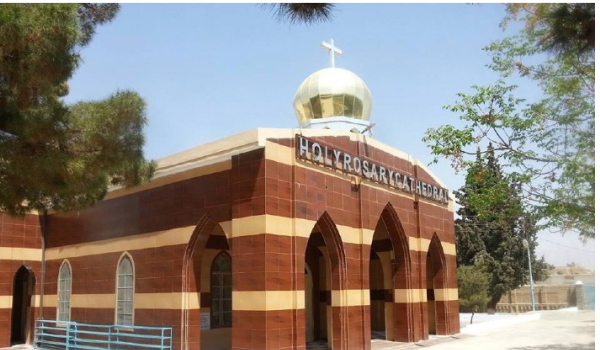
The Apostolic Vicariate of Quetta is the largest in the country by geographical area but most impoverished both ecclesiastically and economically. It is the poorest and least populated church jurisdiction.
Cultural landscape of Balochistan portrays various ethnic groups. People speak different languages including Balochi, Brahvi, Pashto and Urdu.
Quetta Apostolic Vicariate has its roots beginning in the reign of the British Empire in 1697, when the Vicariate of the Great Mogul was established, which included the lands Balohistan. In 1832, the Vicariate formed a part of the Archdiocese of Bombay and in 1878 it was passed to the mission of Afghanistan, which had been entrusted to the Mill Hill missionaries. Quetta, in the years to follow would be visited by Jesuits (who left in 1935) and then Franciscans (until 1982). In 1982, the pastoral care of the local community was entrusted to the Missionary Oblates of Mary Immaculate (OMI), later reinforced by Salesians.
The climate of the upper highlands is characterized by very cold winters and warm summers. Winters of the lower highlands vary from extremely cold in the northern districts to mild conditions closer to the Makran coast. Summers are hot and dry. The arid zones of Chaghi and Kharan districts are extremely hot in summer. The plain areas are also very hot in summer with temperatures rising as high as 50 degrees C (120 degrees F). Winters are mild on the plains with the temperature, never falling below the freezing point. The desert climate is characterized by hot and very arid conditions. Occasionally strong windstorms make these areas very inhospitable.
Balochistan is rich in mineral resources; it is the second major supplier, after Sindh province, of natural gas. In the period spanning 1972-73 to 2005-06 the provincial economy expanded by 2.7 per cent per annum which was much slower than the performance of the other four provinces. It scores lowest in 10 key indicators for education, literacy, health, water and sanitation for 2006-07.
It comprises the entire province of Balochistan, that constitutes about 44% of the entire territory of Pakistan. It extends over an area of 347,188 square kilometers. It includes divisions of Quetta, Kalat, Saibi, Zhob, Nasirabad and Makran. It also includes districts of Quetta, Killa saifullah, Chagai, Pishin, Kila Abdullah, Kalat, Awaran, Mastung, Kharan, Las Bela, Khuzdar, Sibi, Ziarat, Kohlu, Dera Bugti, Zhob, Musa Khel Bazar, Barkhan, Loralai, Nasirabad, Jhal Magri, Bolan, Khachhi, Jafarabad, Gwadar, Panjgur and Turbat.
A number of tribes constitute to make people of Balochistan. Three major tribes are Baloch, Pashtoon and Brahvi. The tribal chief is called Sardar while head of sub-tribe is known as Malik or Mir. Sardars and Maliks are members of district and other local Jirgas according to their status. The Baluchis, believed to have originally come from Arabia or Asia minor. Most of Brahvi speaking tribes are bi-lingual and are quite fluent both in the Baluchi and Brahvi Languages. There are Pashtoon tribes alsoPopular instruments in Balochi music are the sarod, doneli, and benju. Of special note are Sepad, Shabtagi, Vazbad, Lullaby, and Zayirak, various melodies which are sung in rituals after the birth of a child, while lullabies are sung to infants and children.